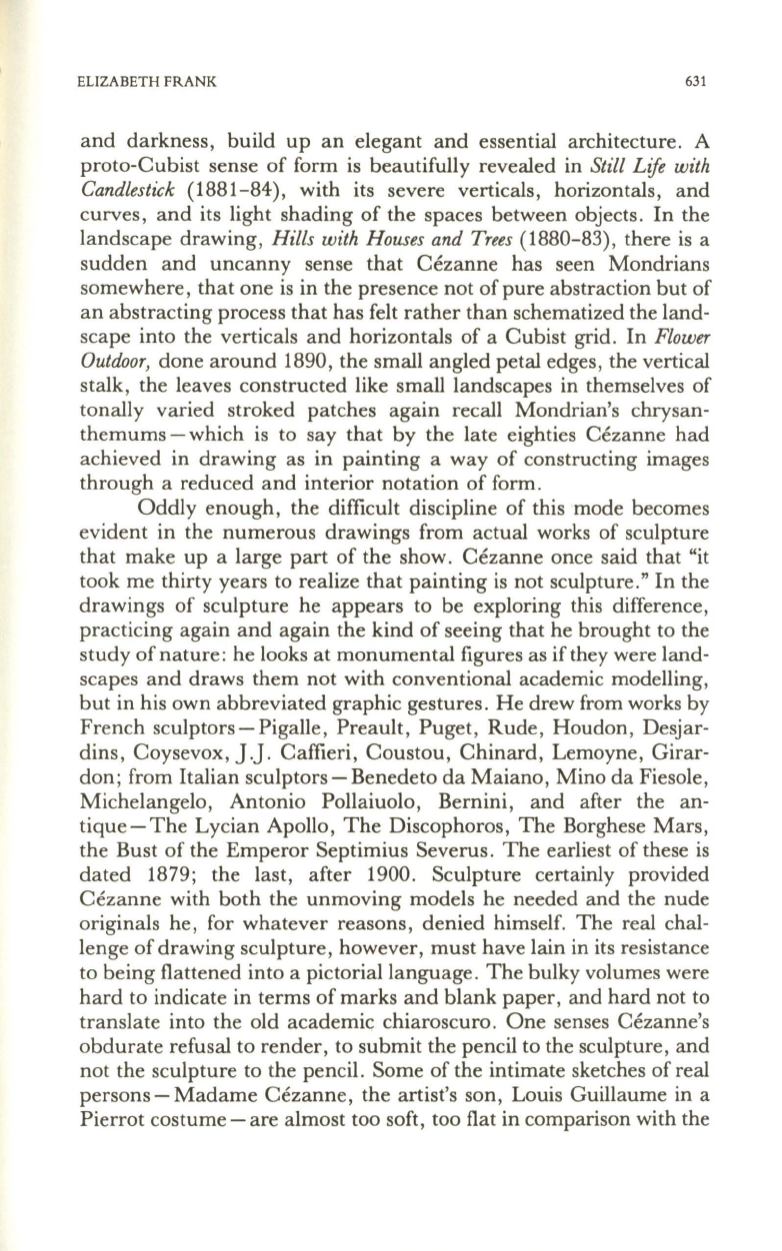
ELIZABETH FRANK
631
and darkness, build up an elegant and essential architecture. A
proto-Cubist sense of form is beautifully revealed in
Still Life with
Candlestick
(1881-84),
with its severe verticals, horizontals, and
curves, and its light shading of the spaces between objects. In the
landscape drawing,
Hills with Houses and Trees
(1880-83),
there is a
sudden and uncanny sense that Cezanne has seen Mondrians
somewhere, that one is in the presence not of pure abstraction but of
an abstracting process that has felt rather than schematized the land–
scape into the verticals and horizontals of a Cubist grid. In
Flower
Outdoor,
done around
1890,
the small angled petal edges, the vertical
stalk, the leaves constructed like small landscapes in themselves of
tonally varied stroked patches again recall Mondrian's chrysan–
themums - which is to say that by the late eighties Cezanne had
achieved in drawing as in painting a way of constructing images
through a reduced and interior notation of form .
Oddly enough, the difficult discipline of this mode becomes
evident in the numerous drawings from actual works of sculpture
that make up a large part of the show. Cezanne once said that "it
took me thirty years to realize that painting is not sculpture." In the
drawings of sculpture he appears to be exploring this difference,
practicing again and again the kind of seeing that he brought to the
study of nature: he looks at monumental figures as if they were land–
scapes and draws them not with conventional academic modelling,
but in his own abbreviated graphic gestures. He drew from works by
French sculptors - Pigalle, Preault, Puget, Rude, Houdon, Desjar–
dins, Coysevox,
J.J.
Caffieri, Coustou, Chinard, Lemoyne, Girar–
don; from Italian sculptors-Benedeto da Maiano, Mino da Fiesole,
Michelangelo, Antonio Pollaiuolo, Bernini, and after the an–
tique - The Lycian Apollo, The Discophoros, The Borghese Mars,
the Bust of the Emperor Septimius Severus. The earliest of these is
dated
1879;
the last, after
1900.
Sculpture certainly provided
Cezanne with both the unmoving models he needed and the nude
originals he, for whatever reasons, denied himself. The real chal–
lenge of drawing sculpture, however, must have lain in its resistance
to being flattened into a pictorial language. The bulky volumes were
hard to indicate in terms of marks and blank paper, and hard not to
translate into the old academic chiaroscuro. One senses Cezanne's
obdurate refusal to render, to submit the pencil to the sculpture, and
not the sculpture to the pencil. Some of the intimate sketches of real
persons - Madame Cezanne, the artist's son, Louis Guillaume in a
Pierrot costume - are almost too soft, too flat in comparison with the


